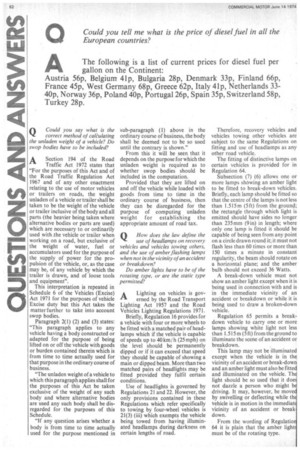Q How does the law define the use of headlamps on
Page 64

If you've noticed an error in this article please click here to report it so we can fix it.
recovery vehicles and vehicles towing others, and the use of amber flashing lamps when not in the vicinity of an accident or breakdown?
Do amber lights have to be of the rotating type, or are the static type permitted?
ALighting on vehicles is governed by the Road Transport Lighting Act 1957 and the Road Vehicles Lighting Regulations 1971.
Briefly, Regulation 16 provides for a vehicle with four or more wheels to be fitted with a matched pair of headlamps which if the vehicle is capable of speeds up to 40 km/ h (25 mph) on the level should be permanently dipped or if it can exceed that speed • they should be capable of showing a main or dipped beam. More than two matched pairs of headlights may be fitted provided they fulfil certain conditions.
Use of headlights is governed by Regulations 21 and 22. However, the only provisions contained in these Regulations which refer specifically to towing by four-wheel vehicles is 21(3) (iii) which exempts the vehicle being towed from having illuminated headlamps during darkness on certain lengths of road. Therefore, recovery vehicles and vehicles towing other vehicles are subject to the same Regulations on fitting and use of headlamps as any other road vehiCle.
The fitting of distinctive lamps on certain vehicles is provided for in Regulation 64.
Subsection (7) (6) allows one or more lamps showing an amber light to be fitted to break-down vehicles. Briefly, each lamp should be fitted so that the centre of the lamps is not less than 1.515 m (5ft) from the ground; the rectangle through which tight is emitted should have sides no longer than 235 mm (9 in) in length; where only one lamp is fitted it should be capable of being seen from any point on a circle drawn round it; it must not flash less than 60 times or more than 150 times a minute in constant regularity, the beam should rotate on a horizontal plane; and the amber bulb should not exceed 36 Watts.
A break-down vehicle must not show an amber light except when it is being used in connection with and is in the immediate vicinity of an accident or breakdown or while it is being used to draw a broken-down vehicle.
Regulation 65 permits a breakdown vehicle to carry one or more lamps showing white light not less than 1.515 m (5 ft) from the ground to illuminate the scene of an accident or breakdown.
This lamp may not be illuminated except when the vehicle is in the vicinity of an accident or break-dow and an amber light must also be fitte and illuminated on the vehicle. Th light should be so used that it doe not dazzle a person who might b driving. It may, however, be move by swivelling or deflecting while th Vehicle is in motion in the irnrnediat vicinity of an accident or break down.
From the wording of Regulatio 64 it is plain that the amber light must be of the rotating type.




























































































































